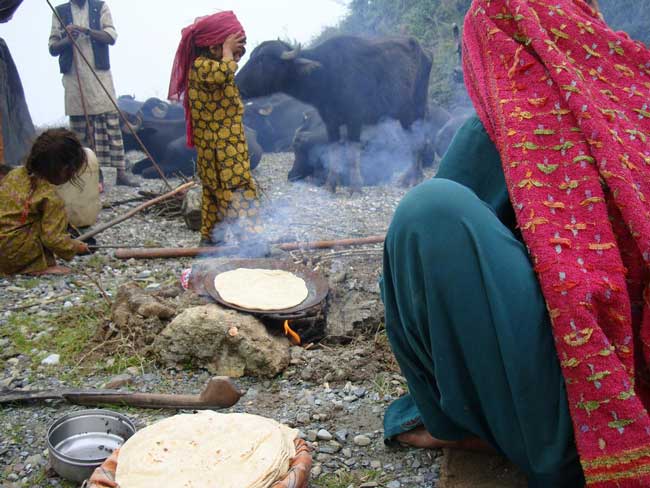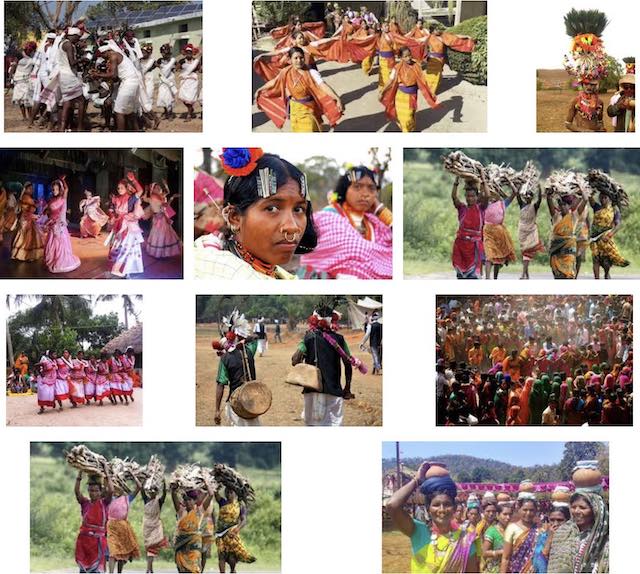
in the Himalayas © Photo Susan MacMillan | Article by Manshi Asher: Down to Earth >>
Gujjar community and India’s Himalayan regions >>
Nomadic and Semi-Nomadic Tribes | SEED – Government scheme
Ecology and environment | Economy and development >>
Ethnobotany & ethnomedicine >>
Nestled in the lap of the Himalayas, Uttarakhand is one of the most beautiful northern states of India that enthralls everyone with its spectacularly scenic landscapes. Charming hill stations juxtaposed against snow-capped peaks, quaint villages along winding mountain roads, serpentine rivers carving their way through the hills, world renowned conservation parks like ‘Jim Corbett Tiger National Park’ and ‘Asan Wetland Conservation Reserve’, world heritage sites like ‘Valley of Flowers’ and ‘Nanda Devi Biosphere Reserve’, waterfalls hurtling down slopes and serene lakes shimmering amidst beautiful towns – that’s Uttarakhand for you. […]
Source: Uttarakhand Tourism Development Board
URL: https://forest.uk.gov.in/pages/view/20-home_page
Date visited: 28 December 2020
The Uttarakhand of today brims with the lively hum of life with people from various communities and religions contributing to make it into a wonderful profusion of the festival called life. The original natives of the land of Uttarakhand belong to different tribes having their distinct and plentiful culture. Major tribes of Uttarakhand include Bhotias (or Shaukas), TribalsRangs [?], Tharus, Buxas, Jaunsaris, Rajis (or Banrawats) apart from indigenous groups like Mahigeers and Vangujjars [Van Gujjars].
The Bhotia is a generic name that includes the Shaukas of Munsyari (Pithoragarh), Rangs of Dharchula(Pithoragarh), Tolchhas and Marchhas of Niti and Mana valleys (Chamoli) and Jads of harsil (uttarkashi). Most of these semi-nomadic pastoral groups are however brought under one anthropological term – Shauka.
The Tharus were once the largest scheduled tribes in the erstwhile state of U.P. and are now concentrated in the Khatima and Sitarganj tehsils of Udham Singh Nagar district. They claim their ancestry from Kirata. Some researchers regard them as descendants are of the Rajputs, while some others trace their origin from the Mongols of Central Asia. Their language is heavily influenced by Hindi and Nepali.
The joint family system is very inherent here. The Biradari Panchayat is the political organization of the Tharus. The Tharus also believe in 36 deities, as well as in witchcraft, sorcery and sacrifices. They offer sacrifices to all their deities except Jagannathi Devta, who is offered milk only. They are an agricultural community who are also fishing experts. Women do not eat the fish touched by men and so the men and women fish separately.
The Buxas are from Mongoloid stock and claim rajput origin. Closely resembling in their habits and customs to Tharus, they are said to be the original inhabitants of the Terai belt and live in Udham Singh Nagar, Dehradun and Pauri Garhwal. They are the followers of Lord Rama and Krishna and worship Hindu deities.
The term ‘Jaunsar’ represents a number of tribal groups namely the Khasas, artisan classes Koltas and baigis who inhabit the Jaunsar area of the Dehradun district.
Rajis, Mahigeers and Vangujjars are other socio-tribal groups whose distinct lifestyles add more colours to the vibrant tribal life of Uttarakhand.
Source: Uttarakhand Tourism Development Board
URL: https://uttarakhandtourism.gov.in/activity/tribals/
Date visited: 28 December 2020
More about the nomadic tribe known as “Van Gujjar”
Located along the foothills of the Shivalik range, the Rajaji National Park spans 820 square kilometres and is home to the Van Gujjars in the winters. The tribe is one of the few forest-dwelling nomadic communities in the country.
Usually, they migrate to the bugyals (grasslands) located in the upper Himalayas with their buffaloes and return only at the end of monsoons to their makeshift huts, deras, in the foothills. The Van Gujjars traditionally practice buffalo husbandry; a family owns up to 25 heads of buffaloes. They rely on buffaloes for milk, which gets them a good price in Uttarakhand and Uttar Pradesh markets.
They have been known to make a sustainable use of forest resources as forests cater to fodder needs of the cattle. “Their movement this season was severely restricted due to the novel coronavirus disease (COVID-19) lockdown,” said Joshi.
He added that he spoke to Chief Secretary Utpal Kumar Singh who then sent letters to the forest departments, but the movement wasn’t still allowed.
He claimed they tried to arrange fodder for the tribe’s animals. “But the forest department didn’t do anything about it,” he said.
More than 64 per cent of Uttarakhand’s geographical area is under the control of the forest department and a huge chunk of the population is dependent on forests.
Though the Uttarakhand government notified the FRA in the state in November 2008 — issuing an order for the establishment of state district-level committees and block district-level committees and constituting Forest Rights Committees — no awareness or training programmes were conducted by the government. Moreover, regular incidents of evictions came to light in the past. […]
Source: “Uttarakhand Van Gujjars allege forest officials assaulted women; probe underway” by Sushmita (Down to Earth, 20 June 2020)
URL: https://www.downtoearth.org.in/news/forests/uttarakhand-van-gujjars-allege-forest-officials-assaulted-women-probe-underway-72036
Date visited: 28 December 2020
Uttarakhand is beautiful state set at the foothills of the snow clad Himalayas with lush green vegetation. There is a diverse range of flora and fauna in Uttarakhand, India. The vegetation of the state majorly comprises alpine trees and tropical rainforests. Wildlife in Uttarakhand thrives in these dense forests. With the varied flora and fauna in Uttarakhand, a number of National Parks have been set up in different parts of the country, which not only serve as a natural habitat for Uttarakhand flora and fauna, but also as a huge source of information for tourists who visit these parks. […]
Uttarakhand comprises of 13 districts spreading over an area of 51,082 sq km, floristically, it falls under the west Himalayan Biogeography zone and it is well-known for floral diversity similar to any other Himalayan region in the country with an estimated 4,000 species of flowering plants having great economic medicinal, aromatic and artistic value. The endemic plant wealth of Uttarakhand is worth mentioning as it ultimately forms part of the National heritage. Uttarakhand Himalayas have about 116 species as indigenous group. […]
Many small river valleys offer wonderful experience to nature lovers and hikers. The vast open hay field, above the tree line present endless views of the variously colored Himalayan flowers. The most interesting of them, aesthetically or botanically are seen in the higher altitudes, from 2,450 meters and above. The arrival of spring brings forward an uprising of colours when the Semal and Palash put the lower altitude forests on fire with their blazing red flowers. It is also the time for Burans to spread its fire at a height of or above 2,450 metres adding colour to the blue and white panorama of snow. The flowers do not grow only in the Valley of Flowers but are found on different treks habitually up to great heights as also on the hayfield and even in rock cracks or moraines.
Source: Uttarakhand Forest, Government of Uttarakhand
URL: https://forest.uk.gov.in/pages/view/20-home_page
Date visited: 28 December 2020
[Bold typeface added above for emphasis]
Up-to-date reports by Indian experts and journalists
Search tips
Combine the name of any particular state, language or region with that of any tribal (Adivasi) community.
Add keywords of special interest (music, poetry, dance just as health, sacred grove and biodiversity); learn about the rights of Scheduled Tribes such as the “Forest Rights Act” (FRA); and the United Nations “Declaration on the Rights of Indigenous Peoples”, “Universal Declaration of Human Rights”, “women’s rights”, or “children’s right to education”.
Ask a question that includes “tribal” or “Adivasi”, for instance: “Adivasi way of life better?” (or “tribal way of life worse?”)
Specify any particular issue or news item (biodiversity, bonded labour and human trafficking, climate change, ecology, economic development, ethnobotany, ethnomedicine, global warming, hunter-gatherers in a particular region or state, prevention of rural poverty, water access).
For official figures include “scheduled tribe ST” along with a union state or region: e.g. “Chhattisgarh ST community”, “Himalayan tribe”, “Scheduled tribe Tamil Nadu census”, “ST Kerala census”, “Particularly Vulnerable Tribal Group Jharkhand”, “PVTG Rajasthan”, “Adivasi ST Kerala”, “Adibasi ST West Bengal” etc.
In case the Google Custom Search window is not displayed here try the following: (1) toggle between “Reader” and regular viewing; (2) in your browser’s Security settings select “Enable JavaScript” | More tips >>
Note: hyperlinks and quotes are meant for fact-checking and information purposes only | Disclaimer >>
List of websites covered by this Google custom search engine
Academia.edu (platform for academics to share research papers) – www.academia.edu
Archive.org – https://archive.org
Centre for Science and Environment – https://www.cseindia.org
Current Conservation – https://www.currentconservation.org
Development and Cooperation (D+C) https://www.dandc.eu
Down To Earth (India) – www.downtoearth.org.in
India Environment Portal – www.indiaenvironmentportal.org.in
Harnessing Nature Magazine – https://harnessingnature.online
Mongabay-India – https://india.mongabay.com
M S Swaminathan Research Foundation – www.mssrf.org
Navdanya (protecting India’s biodiversity based food heritage) – https://navdanya.org
Third World Network (Penang, Malaysia) – https://twn.my
The Shola Trust (nature conservation in the Nilgiri region) – www.thesholatrust.org

Indian online periodicals and platforms | Images view >>
~ ~ ~
Personalize your CustomSearch by combining other search words >>
(e.g. name of a tribal community and region, a craft, or dance and puppetry)
Research the above issues with the help of Shodhganga: A reservoir of theses from universities all over India, made available under Open Access >>
Note: hyperlinks and quotes are meant for fact-checking and information purposes only | Disclaimer >>
Tips for using interactive maps
Toggle to normal view (from reader view) should the interactive map not be displayed by your tablet, smartphone or pc browser
For details and hyperlinks click on the rectangular button (left on the map’s header)
Scroll and click on one of the markers for information of special interest
Explore India’s tribal cultural heritage with the help of another interactive map >>